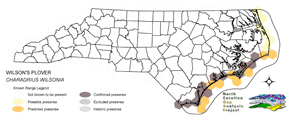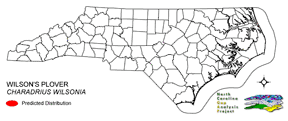
| Taxa: |
| Order: |
| Family: |
| Aves |
| Charadriiformes |
| Charadriidae |
| NatureServe Global Rank: |
| NatureServe State (NC) Rank: |
| G5 |
| S3B,SZN |
| Federal Status: |
| NC State Status: |
| --- |
| SR |


| Land Unit |
| US Fish & Wildlife Service |
| US Forest Service |
| US National Park Service |
| US Department of Defense |
| NC State Parks |
| NC University System |
| NC Wildlife Res. Com. |
| NC Forest Service |
| NC Div. of Coastal Mgmt. |
| Local Governments |
| Non-Governmental Org. |
| Other Public Lands |
| Private Lands |
| GAP Status 1-2 |
| All Protected Lands |
| Statewide |
| Hectares |
| 606.87 |
| 0.00 |
| 463.32 |
| 5,217.48 |
| 673.02 |
| 0.00 |
| 0.00 |
| 0.00 |
| 415.44 |
| 0.00 |
| 57.78 |
| 0.00 |
| 9,188.01 |
| 3,918.15 |
| 7,410.06 |
| 16,621.92 |
| Acres |
| 1,499.61 |
| 0.00 |
| 1,144.89 |
| 12,892.67 |
| 1,663.07 |
| 0.00 |
| 0.00 |
| 0.00 |
| 1,026.57 |
| 0.00 |
| 142.78 |
| 0.00 |
| 22,704.06 |
| 9,681.96 |
| 18,310.65 |
| 41,073.65 |
| % of Dist. on |
| Prot. Lands |
| 8.2 % |
| 0.0 % |
| 5.9 % |
| 70.4 % |
| 9.1 % |
| 0.0 % |
| 0.0 % |
| 0.0 % |
| 5.6 % |
| 0.8 % |
| 0.8 % |
| 0.0 % |
| 0.0 % |
| 52.9 % |
| ----- |
| ----- |
| % of Dist. on |
| All Lands |
| 3.7 % |
| 0.0 % |
| 2.8 % |
| 31.4 % |
| 4.0 % |
| 0.0 % |
| 0.0 % |
| 0.0 % |
| 2.5 % |
| 0.0 % |
| 0.3 % |
| 0.0 % |
| 55.3 % |
| 23.6 % |
| ----- |
| ----- |
|
Strictly a coastal species (Hayman et al. 1986). Fairly common from Portsmouth Island south; uncommon from Hatteras Inlet to Ocracoke Inlet (Fussell 1994). Usually found on inlet sand flats and mud flats, especially where sand has accreted at the end of an island (Fussell 1994). Breeds around lagoons, on sandy beaches, sandbars, (Hayman et al. 1986), edges of sand dunes, and open shell beaches with scattered vegetation above rack line (Harrison 1975). Nests in the open or beneath beach grass, often near a conspicuous object such as a piece of driftwood, mangrove seedling, stump, clump of grass, debris, etc. (Harrison 1975). Tends to forage on higher, drier areas of beach (Hayman et al. 1986). NATURE SERVE GLOBAL HABITAT COMMENTS: Sandy beaches, shell beaches, barrier islands, borders of salt ponds, tidal mudflats, and savanna pools, rarely far from coastal areas. Nests on ground in open on sand and shingle, often by a piece of driftwood or some large object, or by grass tuft (Harrison 1978). In Virginia, nests on the upper portions of sandy beaches on barrier islands, usually within 30 m of dune vegetation but not in dense vegetation; sometimes on overwash flats behind the dunes (Byrd and Johnston 1991). |
| Code | Name | Description | NC Natural Heritage Program Equivalent |
| 378 | Ocean Beaches | Open beach sand. | Upper Beach |
| 375 | Hypersaline coastal salt flats | Tidal flats within salt marshes, including saltmeadow cordgrass or sea-purslane dominated alliances. | Salt Marsh |
| 372 | Interdune Herbaceous Wetlands | Dune swales with permanently flooded to intermittently exposed hydrology. Species composition depends on salinity and can include cut grass, spike-rush, mosquito fern, and hornwort. | Interdune Pond, Maritime Wet Grasslands |
| 371 | Maritime Grasslands | Dune grass community consisting of sea oats and beach grasses. | Dune grass, Maritime dry grassland |
| 60 | Sand | Exposed sand, predominantly in the sandhills region where disturbance or the extreme site conditions prevent natural regeneration. | No equivalent |
|
Thibault, M., and R. McNeil. 1994. Day/night variation in habitat use by Wilson's plovers in northeastern Venezuela. Wilson Bull. 106:299-310.
Bent, A.C. 1929. Life histories of North American shore birds. Part II. U.S. National Museum Bulletin No. 146. Washington, D.C. Fussell, J.O. III. 1994. A birderís guide to coastal North Carolina. Chapel Hill and London: The University of North Carolina Press. Robert, M., R. McNeil, and A. Leduc. 1989. Conditions and significance of night feeding in shorebirds and other water birds in a tropical lagoon. Auk 106:94-101. Harrison, H.H. 1975. A field guide to bird's nests in the U.S. east of the Mississippi River. Houghton Mifflin Company, Boston, Massachusetts. 257 p. Harrison, C. 1978. A field guide to the nests, eggs and nestlings of North American birds. Collins, Cleveland, Ohio. Harrison, H.H. 1979. A field guide to western birds' nests. Houghton Mifflin Company, Boston. 279 pp. Terres, J.K. 1980. The Audubon Society encyclopedia of North American birds. Alfred A. Knopf, New York. American Ornithologists' Union (AOU), Committee on Classification and Nomenclature. 1983. Check-list of North American Birds. Sixth Edition. American Ornithologists' Union, Allen Press, Inc., Lawrence, Kansas. Raffaele, H.A. 1983. A guide to the birds of Puerto Rico and the Virgin Islands. Fondo Educativo Interamericano, San Juan, Puerto Rico. 255 pp. Hayman, P., J. Marchant and T. Prater. 1986. Shorebirds. An identification guide to the waders of the world. Boston: Houghton Mifflin Company. Byrd, M.A., and D.W. Johnston. 1991. Birds. Pages 477-537 in K. Terwilliger, coordinator. Virginia's endangered species:proceedings of a symposium. McDonald and Woodward Publ. Co., Blacksburg, Virginia. Stiles, F.G., and A.F. Skutch. 1989. A guide to the birds of Costa Rica. Comstock Publ. Associates, Cornell University Press, Ithaca, New York. 511 pp. |
For more information please contact them at:
NC-GAP Analysis Project
Dept. of Zoology, NCSU
Campus Box 7617
Raleigh, NC 27695-7617
(919) 513-2853
www.basic.ncsu.edu/ncgap